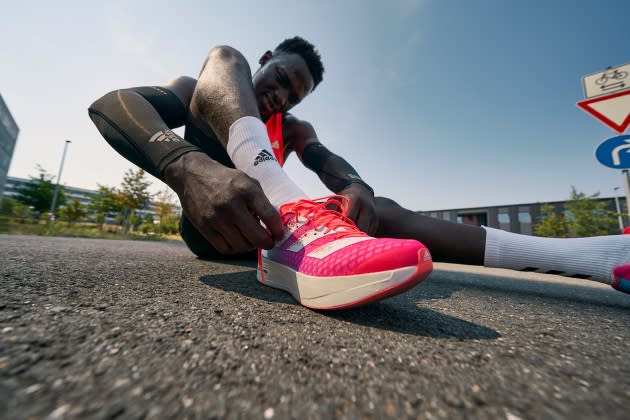‘Severe Challenges’ in China Cast Shadow on Adidas Results

PARIS – Adidas plans to take a 400-million-euro hit to clear excess inventory in China through outlet channels and temporary clearance centers in the second half of the year.
It’s also planning an unspecified project with South Korean girl group Blackpink, and will sign on more Chinese athletes and “cultural partners” as it attempts to tighten connections with Chinese consumers.
More from WWD
“The challenges remain severe,” Adidas chief executive officer Kasper Rorsted told a webcast Thursday as the German sporting goods firm reported a meager 4 percent bump in second-quarter revenues amid a slower-than-expected recovery in China.
Rorsted bristled when a journalist suggested Adidas was ignoring rising political tensions between the East and West following U.S. House Speaker Nancy Pelosi’s visit to Taiwan earlier this week.
Rorsted stressed it’s “too early to say” what the repercussions might be. He acknowledged a “pro-China sentiment” that has fueled some boycotts of Western brands, but stressed that the Communist country’s zero-COVID-19 policy and lockdown measures rank as more overriding concerns.
He noted that about 80 Chinese cities have been partially impacted by lockdowns, and “cautious consumer behavior” is reflected in anemic traffic in Adidas retail stores there.
Store traffic fell 21 percent in July, worse than the 16 percent dip in June, but better than the 54 percent drop in April. January was the only month to record a positive figure: 9 percent up.
Conditions allowing, Adidas plans to stage more local brand activations in the second half – last month its Terrex sub brand held a trail running race in the Chongli district near Beijing – and it remains “optimistic about our brand and its long-term growth prospects in China,” Rorsted said.
Adidas blamed tough China business for recently lowering its full-year guidance, which already factored in a negative top-line impact from inventory takebacks there.
Asked why competitors Puma and Nike have fared better in China recently, Rorsted flagged its large exposure to the market, representing about 12 to 13 percent of the total Adidas business.
In the second quarter, revenues in China fell 35 percent. By contrast, Asia-Pacific gained 3 percent, EMEA 7 percent, North America 21 percent and Latin America 37 percent.
Adidas increased its forecasts for the latter two markets, expecting North America growth in the high-teens and Latin America to grow between 30 percent and 40 percent.
Thursday’s results were broadly in line with market expectations. The company had already lowered its guidance and previewed its results late last month.
While acknowledging “heightened uncertainty” amid multiple external challenges – ranging from the war in Ukraine to inflationary pressures – Rorsted painted a brightening picture in the second half due to easier comps, fewer supply-chain constraints, excitement around soccer ahead of the FIFA World Cup in Qatar in November and December, a strong product pipeline and dynamism in many regions.
“This is a time when the strength of the brand makes a difference,” he commented.
The executive also hinted at “more to come from our fashion partnerships,” which have included Gucci and Balenciaga so far this year. A long-awaited basketball offering with Jerry Lorenzo’s Fear of God is due out in Q4.
According to Adidas calculations, markets representing more than 85 percent of its business grew 14 percent in Q2. Rorsted also trumpeted double-digit growth in its football, running and outdoor categories.
But there were pressures on both supply and demand. Adidas said last year’s lockdowns in Vietnam reduced top-line growth by around 200 million euros in the latest quarter, while the suspension of operations in Russia, once touted to become its top European market, lopped off more than 100 million in revenues. Sales totaled 5.6 billion euros in the three months ended June 30.
Net income from continuing operations slipped 7 percent in the first half to 360 million euros, and this amount was supported by a one-time tax benefit of more than 100 million euros.
Operating profits fell 27.9 percent to 392 million euros.
Looking ahead, Adidas said it now expects growth in the low teens in the EMEA region versus an earlier forecast of mid-teens growth, while Asia-Pacific is projected to grow at a high single-digit rate versus growth in the mid-teens.
The company said it would continue raising prices in the face of higher sourcing and freight costs, citing a 10 percent increase in average selling price in Q2.
In the quarter, marketing and point-of-sale expenses rose 8 percent to 663 million euros.
“The company continued to prioritize investments into the launch of new products such as Adidas’ new Sportswear collection, the next iteration of its successful Supernova running franchise and first drops related to the Gucci collaboration as well as campaigns around major events like ‘Run for the Oceans,'” Adidas said.
Sign up for WWD's Newsletter. For the latest news, follow us on Twitter, Facebook, and Instagram.
